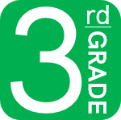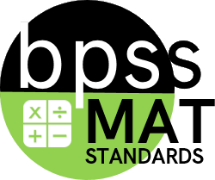BPS District Mathematics Standards Book
K-8 Grade Levels
Grade 03
Third Grade Math
"I can ... statements"
 In 3rd grade, your child will learn important new ideas and gain important new skills. One of the most important topics this year is multiplication and division. Another is fractions. Multiplication, division, and fractions are the building blocks
for many life skills that students will learn in later grades, such as percentages. Students also need to master these topics to be ready for algebra and advanced math, so it is essential to get a good start with these topics in 3rd grade.
In 3rd grade, your child will learn important new ideas and gain important new skills. One of the most important topics this year is multiplication and division. Another is fractions. Multiplication, division, and fractions are the building blocks
for many life skills that students will learn in later grades, such as percentages. Students also need to master these topics to be ready for algebra and advanced math, so it is essential to get a good start with these topics in 3rd grade.
MAT-03.OA Domain:
[OA] Operations and Algebraic Thinking
- MAT-03.OA.01 Interpret and model products of whole numbers.
- MAT-03.OA.02 Interpret and model whole-number quotients of whole numbers, as the number in a group or the number of groups.
- MAT-03.OA.03 Using drawings and equations with a symbol for an unknown number, solve multiplication and division word problems within 100 in situations involving equal groups, arrays, and measurement quantities.
- MAT-03.OA.04 Determine the unknown whole number in a multiplication or division equation relating three whole numbers
- MAT-03.OA.05 Apply properties of operations as strategies to multiply and divide.
- MAT-03.OA.06 Understand division as an unknown-factor problem.
- MAT-03.OA.07 Using mental strategies, fluently multiply and divide within 100
- MAT-03.OA.07.a Fluently multiply basic facts within 100*
- MAT-03.OA.07.b Fluently divide basic facts within 100*
- MAT-03.OA.08 Solve two-step word problems using the four operations. represent these problems using equations with a letter standing for the unknown quantity. Assess the reasonableness of answers using mental computation and estimation strategies
- MAT-03.OA.09 Identify arithmetic patterns, and explain them using properties of operations
MAT-03.NBT Domain:
[NBT] Number and Operations in Base Ten
- MAT-03.NBT.01 Use place value understanding to round whole numbers to the nearest 10 or 100.
- MAT-03.NBT.02 Using strategies and algorithms based on place value, properties of operations, and/or the relationship between addition and subtraction, fluently add and subtract within 1000
- MAT-03.NBT.03 Using strategies based on place value and properties of operations, multiply one-digit whole numbers by multiples of 10 in the range 10-90.
MAT-03.NF Domain:
[NF] Number and Operations Fractions
- MAT-03.NF.01 Understand a fraction 1/b as the quantity formed by 1 part when a whole is partitioned into b equal parts. Understand a fraction a/b as the quantity formed by a parts of size 1/b.
- MAT-03.NF.02 Understand a fraction as a number on the number line; represent fractions on a number line diagram.
- MAT-03.NF.02.a Represent a fraction 1/b on a number line diagram by defining the interval from 0 to 1 as the whole and partitioning it into b equal parts. Recognize that each part has size 1/b and that the endpoint of the part based at 0 locates the number 1/b on the number line.
- MAT-03.NF.02.b Represent a fraction a/b on a number line diagram by marking off a lengths 1/b from 0. Recognize that the resulting interval has size a/b and that its endpoint locates the number a/b on the number line.
- MAT-03.NF.03 - Explain equivalence of fractions in special cases, and compare fractions by reasoning about their size.
- MAT-03.NF.03.a Understand two fractions as equivalent (equal) if they are the same size, or the same point on a number line. MAT-03.NF.03.b Recognize and generate simple equivalent fractions. Explain why the fractions are equivalent using a visual fraction model.
- MAT-03.NF.03.c Recognize fractions, a/1 or a/a, that are equivalent to whole numbers. Express whole numbers as fractions, a/1 or a/a.
- MAT-03.NF.03.d Compare two fractions with the same numerator or the same denominator by reasoning about their size.
- 03.NF.03.e Recognize that comparisons are valid only when the two fractions refer to the same whole.
- 03.NF.03.f Record the results of comparisons with the symbols >, =, or <, and justify the conclusions by using a visual fraction model.
MAT-03.MD Domain:
- MAT-03.MD.01 Tell and Write time to the nearest minute and measure time intervals in minutes. solve elapsed time word problems on the hour and the half hour, using a variety of strategies.
- MAT-03.MD.02 Measure and estimate liquid volumes and masses of objects using standard units of grams (g), kilograms (kg), and liters (l). Add, subtract, multiply, or divide to solve one-step word problems involving masses or volumes that are given in the same units.
- MAT-03.MD.03 Draw scaled picture graphs and scaled bar graphs to represent data sets with several categories. Solve one- and two-step how many more and how many less problems using information presented in scaled bar graphs.
- MAT-03.MD.04 Generate measurement data by measuring lengths using rulers marked with halves and fourths of an inch. Show the data by making a line plot, where the horizontal scale is marked in appropriate unitsùwhole numbers, halves, or quarters.
- MAT-03.MD.05 Recognize area as an attribute of plane figures and understand concepts of area measurement.
- MAT-03.MD.05.a A square with a side length 1 unit, called a unit square, is said to have one square unit of area, and can be used to measure area.
- MAT-03.MD.05.b A plane figure, which can be covered without gaps or overlaps by n unit squares, is said to have an area of n square units.
- MAT-03.MD.06 Measure areas by counting unit squares (square cm, square m, square in, square ft, and improvised units).
- MAT-03.MD.07 Relate area to the operations of multiplication and addition.
- MAT-03.MD.07.a Find the area of a rectangle with whole-number side lengths by tiling it, and show that the area is the same as would be found by multiplying the side lengths.
- MAT-03.MD.07.b Multiply side lengths to find areas of rectangles with whole-number side lengths in the context of solving real world and mathematical problems, and represent whole-number products as rectangular areas in mathematical reasoning.
- MAT-03.MD.07.c Use tiling to show in a concrete case that the area of a rectangle with whole-number side lengths a and b + c is the sum of a ╫ b and a ╫ c. Use area models to represent the distributive property in mathematical reasoning.
- MAT-03.MD.07.d Recognize area as additive. Find areas of rectilinear figures by decomposing them into non-overlapping rectangles and adding the areas of the non-overlapping parts, applying this technique to solve real world problems
- MAT-03.MD.08 Solve real world and mathematical problems involving perimeters of polygons, including finding the perimeter given the side lengths. Find an unknown side length. Exhibit rectangles with the same perimeter and different area or with the same area and different perimeters
MAT-03.G Domain:
- MAT-03.G.01 Understand that shapes in different categories may share attributes, and that the shared attributes can define a larger category. Recognize rhombuses, rectangles, and squares as examples of quadrilaterals. Draw examples of quadrilaterals that do not belong to any of these subcategories
- MAT-03.G.02 Partition shapes into parts with equal areas. Express the area of each part as a unit fraction of the whole.
A Sample of What Your Child Will Be Working on in Grade 03
- Multiplying and dividing up to 10 × 10 quickly and accurately, including knowing the times tables from memory
- Solving word problems using addition, subtraction, multiplication, and division
- Beginning to multiply numbers with more than one digit (e.g., multiplying 9 × 80)
- Understanding fractions and relating them to the familiar system of whole numbers (e.g., recognizing that 3⁄1 and 3 are the same number)
- Measuring and estimating weights and liquid volumes, and solving word problems involving these quantities
- Reasoning about shapes (e.g., all squares are rectangles but not all rectangles are squares)
- Finding areas of shapes, and relating area to multiplication (e.g., why is the number of square feet for a 9-foot by 7-foot room given by the product 9 × 7?)
